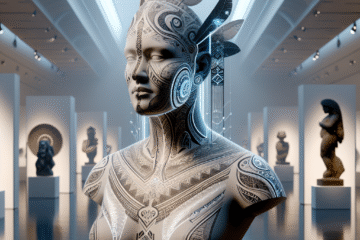I. Introduction
- Definition of digital painting
- Importance of realistic effects in digital paintings
Digital painting is the process of creating a digital artwork using computer software and digital tools. These tools can include a graphics tablet, stylus, and specialized digital painting software. Digital painting allows artists to create highly detailed and realistic artwork, as well as more stylized and expressive pieces.
Realistic effects are an important aspect of digital painting, as they can help bring a sense of realism and believability to an artwork. Realistic lighting, shading, and textures can all contribute to a sense of realism in a digital painting. In addition, accurate representation of form and perspective can also add to the realism of a digital painting.
While realism is not always the goal in digital art, it can be a useful technique to master in order to create more believable and lifelike artwork. By learning how to create realistic effects in their digital paintings, artists can add depth and detail to their work, and create more immersive and believable digital artworks.
II. Setting up your canvas and tools
- Choosing the right software and hardware
- Setting up your canvas size and resolution
When it comes to creating digital paintings, it’s important to start with the right setup. This includes choosing the right software and hardware, as well as setting up your canvas size and resolution.
Choosing the right software and hardware: There are many different options when it comes to digital painting software, each with their own unique features and tools. Some popular choices include Adobe Photoshop, Corel Painter, and Procreate. It’s important to choose software that fits your needs and budget, as well as one that you feel comfortable using.
In addition to software, it’s also important to choose the right hardware for digital painting. A graphics tablet is a must-have for digital painting, as it allows for more precise and natural drawing and painting compared to using a mouse. A stylus, which is a pen-like tool used with a graphics tablet, can also be helpful in creating more detailed and expressive digital paintings.
Setting up your canvas size and resolution: Before you start painting, it’s important to set up your canvas size and resolution. The size of your canvas will depend on the size and resolution of the final artwork you want to create. For example, if you want to create a digital painting that will be printed as a large poster, you’ll need a larger canvas size with a higher resolution. On the other hand, if you’re creating a small digital painting for the web, a smaller canvas size with a lower resolution will suffice.
It’s also important to consider the resolution of your canvas, as this will affect the quality and clarity of your final artwork. A higher resolution will result in a clearer and more detailed image, while a lower resolution may result in a pixelated or blurry image.
By setting up your canvas and tools correctly, you’ll be well on your way to creating beautiful and realistic digital paintings.
III. Sketching and line work
- Sketching techniques for digital paintings
- Importance of good line work in creating realistic effects
Sketching and line work are important early steps in creating a digital painting, as they help to establish the overall composition and structure of the artwork. There are several techniques that can be used when sketching for digital paintings, and it’s a good idea to experiment with different approaches to see what works best for you.
Sketching techniques for digital paintings: One approach is to start with a loose, rough sketch to get a feel for the composition and overall structure of the artwork. This can be done using a rough brush or pencil tool in your digital painting software. From there, you can refine the sketch by adding more detail and refining the line work.
Another approach is to sketch directly in ink or a thin line tool, which can give a more finished look to the sketch. This can be a good option if you want to skip the rough sketch stage and go straight to a more finished line drawing.
Importance of good line work in creating realistic effects: Good line work is important in creating realistic effects in digital paintings, as it helps to define the forms and shapes in the artwork. By using thin, precise lines, you can create the illusion of form and depth in your digital paintings. In addition, using different line widths and styles can add interest and variety to your line work.
Overall, sketching and line work are crucial steps in creating a digital painting, and it’s worth taking the time to get them right. By developing good sketching and line work skills, you’ll be well on your way to creating highly realistic and professional-looking digital paintings.
IV. Shading and lighting
- Techniques for creating realistic shading and lighting in digital paintings
- Tips for making your shading and lighting look natural and believable
Shading and lighting are important elements in creating realistic effects in digital paintings. By using various shading and lighting techniques, you can add depth, dimension, and believability to your artwork. Here are some tips for creating realistic shading and lighting in your digital paintings.
Techniques for creating realistic shading and lighting: One technique for adding shading to your digital paintings is to use a gradient tool, which allows you to smoothly transition from one color to another. This can be useful for creating the illusion of form and depth in your artwork. You can also use the dodge and burn tools to selectively lighten and darken areas of your painting, which can help create the illusion of light and shadow.
Another technique for adding lighting to your digital paintings is to use lighting effects filters or brushes. These can help you create various lighting effects, such as glow, reflection, and rim lighting.
Tips for making your shading and lighting look natural and believable: To make your shading and lighting look natural and believable, it’s important to consider the direction and intensity of the light source in your painting. You should also pay attention to the way that light interacts with different surfaces, as this can affect the way that light and shadow are cast.
It’s also a good idea to study reference photos or real-life lighting situations to get a feel for how light behaves in different situations. This can help you create more realistic lighting effects in your digital paintings.
By using these techniques and tips, you’ll be well on your way to creating realistic and believable shading and lighting in your digital paintings.
V. Textures and details
- Adding textures to your digital paintings
- Tips for creating realistic details in your paintings
Textures and details are important elements in creating realistic effects in digital paintings. By adding various textures and details to your artwork, you can add depth, dimension, and believability to your digital paintings. Here are some tips for adding textures and creating realistic details in your digital paintings.
Adding textures to your digital paintings: There are many different ways to add textures to your digital paintings. One method is to use texture brushes or stamps, which allow you to apply pre-made texture effects to your artwork. You can also create your own custom texture brushes by scanning or photographing real-life textures and importing them into your digital painting software.
Another method is to use layer styles, such as bevel and emboss, to add texture to your artwork. You can also use the filter gallery to apply texture effects to your painting.
Tips for creating realistic details in your paintings: To create realistic details in your digital paintings, it’s important to pay attention to the way that light and shadow interact with different surfaces. You should also study reference photos or real-life objects to get a feel for the way that different surfaces and materials behave.
It’s also a good idea to use a variety of brush sizes and styles when adding details to your digital paintings. This can help create a sense of depth and dimension in your artwork.
Overall, adding textures and creating realistic details can take your digital paintings to the next level, and it’s worth taking the time to get them right. By using these techniques and tips, you’ll be well on your way to creating highly realistic and professional-looking digital paintings.
VI. Color
- Choosing the right color palette for realistic effects
- Techniques for blending and layering colors in digital paintings
Color is an important element in digital painting, as it can help create mood, emotion, and realism in your artwork. Here are some tips for choosing the right color palette and blending and layering colors in your digital paintings.
Choosing the right color palette for realistic effects: When it comes to creating realistic effects in your digital paintings, it’s important to choose a color palette that is appropriate for the subject matter and lighting conditions of your artwork. For example, if you’re painting a landscape scene, you’ll want to choose a color palette that accurately reflects the colors of the sky, land, and vegetation.
It’s also a good idea to consider the mood and atmosphere of your artwork when choosing your color palette. For example, a warm, vibrant color palette can create a lively and energetic mood, while a cool, muted color palette can create a more calming and peaceful mood.
Techniques for blending and layering colors in digital paintings: There are several techniques for blending and layering colors in digital paintings. One technique is to use the gradient tool to smoothly blend colors together. You can also use the brush tool to manually blend colors together by using circular brushstrokes or a low opacity setting.
Another technique is to use layer blending modes, which allow you to blend the colors and tones of different layers together in various ways. For example, the multiply blending mode can darken the colors of one layer by multiplying them with the colors of the layer beneath it.
By using these techniques and tips, you’ll be well on your way to choosing the right color palette and creating beautiful and realistic color blends in your digital paintings.
VII. Finishing touches
- Finalizing your digital painting and adding finishing touches
- Tips for creating a polished and professional-looking digital painting
After you’ve completed the main elements of your digital painting, it’s time to add the finishing touches. This includes finalizing your painting and adding any additional details or effects to make it look polished and professional. Here are some tips for adding finishing touches to your digital paintings.
Finalizing your digital painting and adding finishing touches: Before you consider your digital painting complete, it’s important to step back and look at it as a whole. Check for any areas that may need further refinement or adjustment, and make any necessary changes.
You can also add additional details and effects to your painting to give it a more polished and professional look. This can include adding highlights and reflections, adjusting the overall color balance, or adding special effects filters.
Tips for creating a polished and professional-looking digital painting: To create a polished and professional-looking digital painting, it’s important to pay attention to the overall composition and balance of your artwork. You should also consider the mood and atmosphere of your painting, and make sure that it is consistent with your intentions.
It’s also a good idea to study the work of other professional digital artists to get an idea of what makes a digital painting look polished and professional. This can help you develop your own style and techniques for creating high-quality digital artworks.
By following these tips and techniques, you’ll be well on your way to creating beautiful and professional-looking digital paintings.
VIII. Conclusion
- Recap of the importance of realistic effects in digital paintings
- Encouragement to continue practicing and improving digital painting skills.
In conclusion, creating realistic effects in digital paintings can add depth, dimension, and believability to your artwork. By mastering techniques for sketching, shading and lighting, adding textures and details, choosing the right color palette, and adding finishing touches, you can create highly realistic and professional-looking digital paintings.
It’s important to remember that creating realistic effects in digital paintings takes time and practice. The more you experiment and practice with different techniques, the better you will become at creating realistic effects in your digital art.
So don’t be afraid to try new things and push yourself to improve your digital painting skills. With dedication and practice, you’ll be well on your way to creating stunning and realistic digital paintings.


